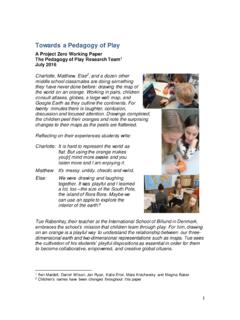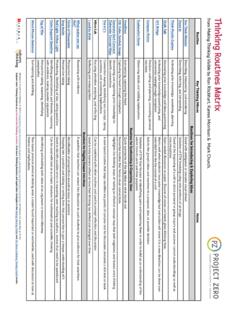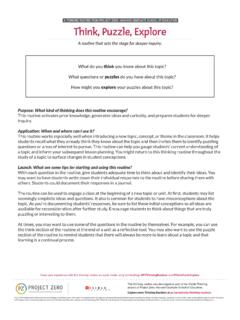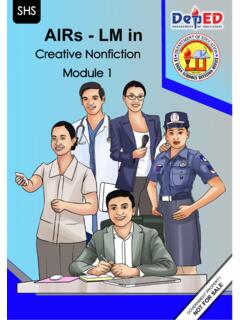Transcription of February 2008 | Volume 5 Teaching Students to Think Making ...
1 February 2008 February 2008 | Volume 65 | Number 5 Teaching Students to Think Pages 57-61 Making Thinking VisibleWhen learners speak, write, or draw their ideas, they deepen their cognition. Project Zero's Visible Thinking approach shows Ritchhart and David PerkinsWhat are your thoughts about arthropods?Chances are you don't have too many thoughts about this particular phylum of invertebrates. But Students in Naomi Arrow's 5th grade class at Bialik College in Melbourne, Australia, came up with many initial observations when Naomi introduced a unit on the creatures, everything from "I Think they're creepy" to "They are hairy and have many legs."1 Beyond first impressions, the Students generated questions on aspects of arthropods that they were puzzled about: "How do they walk upside down?" "How does the spider produce its web?" And (in an intriguing somersault of perspective taking), "Is there stuff that they stamp on, like we stamp on them?
2 "Naomi's Students were applying a thinking routine called Think -puzzle-explore, which has Students share what they Think about a topic, identify questions they puzzle about, and target directions to explore. Thinking routines help learners ponder topics that might not seem to invite intricate thinking at first glance, such as arthropods. Such routines jump-start thinking and make it routines are one element of an initiative called Visible Thinking that we, our colleagues at Project Zero, and collaborators in various schools have developed. In our research, we have explored the practicality of using thinking routines and documentation as classroom learning tools, developed a framework for pursuing cultural transformation in classrooms and schools, and devised tools for integrating the arts. This work has spanned elementary through university settings, included both public and independent schools, and involved schools in the United States, the Netherlands, Sweden, Belgium, and Is Visible Thinking?
3 Six key principles anchor Visible Thinking and characterize our approach in schools. Learning is a consequence of thinking. Students ' understanding of content, and even their memory for content, increases when they Think through and with the concepts and information they are studying. Thinking through issues is not a solo endeavor, however. Team members often share and build on one another's knowledge. Notational systems, specialized vocabulary, and various technological and other tools also free up memory for more complex tasks. Good thinking is not only a matter of skills, but also a matter of dispositions. Open-mindedness, curiosity, attention to evidence, skepticism, and imaginativeness all make for good thinking (Perkins & Ritchhart, 2004; Perkins, Tishman, Ritchhart, Donis, & Andrade, 2000). Such characteristics concern not so much a person's abilities as how the person invests those abilities.
4 Children and adults often greatly underutilize their thinking capabilities. Accordingly, besides nurturing relevant skills, education needs to promote open-mindedness over closed-mindedness, curiosity over indifference, and so on. Several studies support this dispositional view of thinking. The development of thinking is a social endeavor. In classrooms, as in the world, there is a constant interplay between the group and the individual. We learn from those around us and our engagement with them. The sociocultural character of classrooms and schools should ensure that thoughtful learning is pervasive, not sporadic. Fostering thinking requires Making thinking visible. Thinking happens mostly in our heads, invisible to others and even to ourselves. Effective thinkers make their thinking visible, meaning they externalize their thoughts through speaking, writing, drawing, or some other method.
5 They can then direct and improve those thoughts. Visible Thinking also emphasizes documenting thinking for later reflection. Classroom culture sets the tone for learning and shapes what is learned. We have identified eight forces that shape classroom culture: (1) classroom routines and structures for learning, (2) language and conversational patterns, (3) implicit and explicit expectations, (4) time allocation, (5) modeling by teachers and others, (6) the physical environment, (7) relationships and patterns of interaction, and (8) the creation of opportunities. Depending on their form, these forces can support or undermine the rhythm of thoughtful learning (Ritchhart, 2002, 2007). Schools must be cultures of thinking for teachers. Professional learning communities in which rich discussions of Teaching , learning, and thinking become a fundamental part of teachers' experiences provide the foundation for nurturing thinking and learning in the classroom.
6 Administrators need to value, create, and preserve time for teachers to discuss Teaching and learning, grounded in observation of student work. First Grade Thinkers at Work ..To show these principles in action, let's look inside another classroom at Bialik College, a private preK 12 school in Melbourne, Australia. The school includes Students with severe learning disabilities as well as gifted Students . First grade teacher Roz Marks has been implementing visible thinking in her classroom for two years through our Cultures of Thinking project. She has found the Think -puzzle-explore routine a good way to uncover Students ' thinking and plan her inquiry-based curriculum. When her class showed interest in the April 2006 Beaconsfield Mine collapse in Tasmania and the subsequent rescue of two miners, Roz used this routine to help define Students ' her class, Roz asked, "What do you Think you know about the Beaconsfield Mine?
7 " To provide Think time, she gave them paper to draw their ideas. Students were soon eager to share."I Think Larry Knight [the sole fatality] was a good person," Yasmin offered. Roz recorded Yasmin's comment on chart paper and gently pushed her thinking by asking, "What makes you say that?" The 6-year-old paused before speculating, "Because maybe he offered to drive the truck and didn't mind that he wasn't protected."Ivan added, "I Think Larry Knight was scared when the rock was falling."Roz probed, "What makes you say that?" Ivan pointed to his picture: "Because the rock was so big."As the sharing continued, Roz followed each student's statement with "What makes you say that?" and documented responses to keep the collective thinking visible. Soon Students justified their ideas without prompting. "I Think one of the miners is ill," Jade offered, quickly adding, "because I heard it on the news.
8 "Roz turned the class's attention to the mysteries of the mining disaster. "What are you puzzling over or wondering about the mine?" Hands shot up and questions flew. Some questions focused on causes of the tragedy: "How did the collapse happen?" "Why was the cage [part of the vehicle in which miners worked] so small?" "Why was Larry Knight not in the cage?" Others explored the rescue: "Why were the last three meters of rock the hardest?" Still others expressed personal puzzles: "Why wasn't I allowed to watch it on TV?"After collecting Students ' "puzzles" the questions Students puzzled over Roz discussed with the class how varied they were and asked, "How will we explore our puzzles?" Students suggested various media sources, such as newspaper and television. A few recognized the need for "the truth," not just information, and suggested visiting Tasmania or phoning the miners themselves.
9 The class decided to keep looking at and listening to news reports. Roz and the Students regularly brought articles to class, and Students continued to form theories about the collapse and rescue on the basis of new evidence. Roz also made books about geology and mining available to And How Their Teacher Fostered ThinkingIn this interaction, Roz fostered thinking and made it visible in multiple ways. Even before the discussion, Roz signaled interest in her Students ' ideas. Through observing Students ' conversations and play, she recognized the opportunity for rich learning related to the topic of the Beaconsfield Mine. In Roz's classroom, student thinking is noticed, respected, and encouraged, fostering a culture of pervasive gave her Students time to become aware of their ideas and questions, and then used the Think -puzzle-explore routine to support their inquiry. Like the familiar KWL strategy What do you Know?
10 What do you Want to know? What have you Learned? (Lyman, 1981) Think -puzzle-explore taps Students ' prior knowledge, but with a key difference. By asking what Students " Think they know" rather than what they "know," the prompt uses conditional language that suggests possibilities and openness rather than absolutes (Langer & Piper, 1987; Ritchhart & Perkins, 2000). This encourages sharing of tentative ideas. All Students can engage in a conversation focused on personal thoughts rather than definitive knowledge. As the conversation in Roz's class developed, Students adopted conditional language in their responses ("I Think Larry Knight was scared"). Such language communicates the message that learning begins with one's own ideas and truth is built over used the power of language to shape thinking by weaving in the "What makes you say that?" prompt with its gentle invitation to provide evidence.







